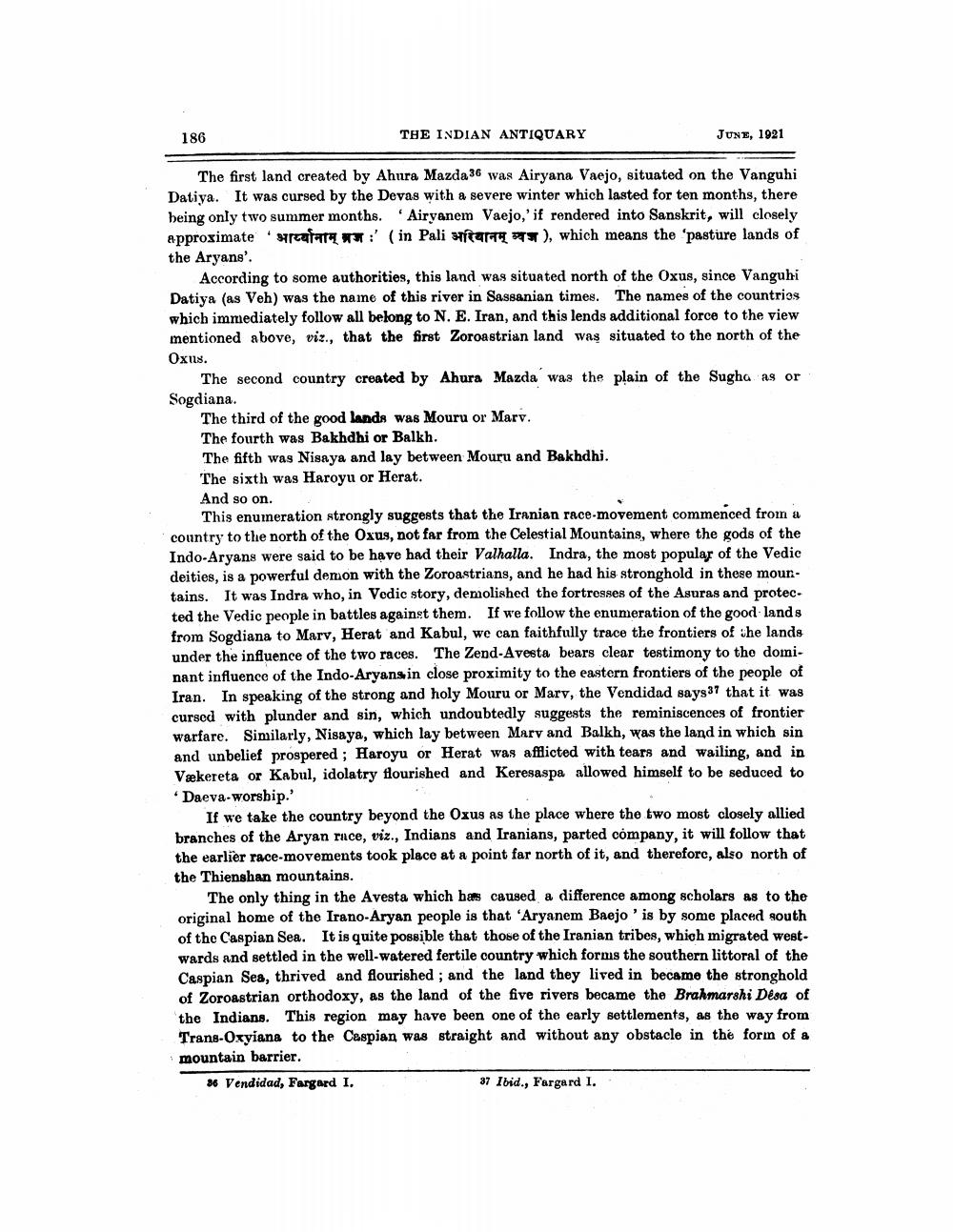________________
186
THE INDIAN ANTIQUARY
The first land created by Ahura Mazda 36 was Airyana Vaejo, situated on the Vanguhi Datiya. It was cursed by the Devas with a severe winter which lasted for ten months, there being only two summer months. Airyanem Vaejo,' if rendered into Sanskrit, will closely approximate refar (in Pali star), which means the 'pasture lands of
JUNE, 1921
the Aryans'.
According to some authorities, this land was situated north of the Oxus, since Vanguhi Datiya (as Veh) was the name of this river in Sassanian times. The names of the countries which immediately follow all belong to N. E. Iran, and this lends additional force to the view mentioned above, viz., that the first Zoroastrian land was situated to the north of the Oxus.
The second country created by Ahura Mazda was the plain of the Sugha as or Sogdiana.
The third of the good lands was Mouru or Marv.
The fourth was Bakhdhi or Balkh.
The fifth was Nisaya and lay between Mouru and Bakhdhi.
The sixth was Haroyu or Herat.
And so on.
This enumeration strongly suggests that the Iranian race-movement commenced from a country to the north of the Oxus, not far from the Celestial Mountains, where the gods of the Indo-Aryans were said to be have had their Valhalla. Indra, the most popular of the Vedic deities, is a powerful demon with the Zoroastrians, and he had his stronghold in these mountains. It was Indra who, in Vedic story, demolished the fortresses of the Asuras and protected the Vedic people in battles against them. If we follow the enumeration of the good lands from Sogdiana to Marv, Herat and Kabul, we can faithfully trace the frontiers of the lands under the influence of the two races. The Zend-Avesta bears clear testimony to the dominant influence of the Indo-Aryans in close proximity to the eastern frontiers of the people of Iran. In speaking of the strong and holy Mouru or Marv, the Vendidad says 37 that it was cursed with plunder and sin, which undoubtedly suggests the reminiscences of frontier warfare. Similarly, Nisaya, which lay between Marv and Balkh, was the land in which sin and unbelief prospered; Haroyu or Herat was afflicted with tears and wailing, and in Vækereta or Kabul, idolatry flourished and Keresaspa allowed himself to be seduced to 'Daeva-worship."
If we take the country beyond the Oxus as the place where the two most closely allied branches of the Aryan race, viz., Indians and Iranians, parted company, it will follow that the earlier race-movements took place at a point far north of it, and therefore, also north of the Thienshan mountains.
The only thing in the Avesta which has caused a difference among scholars as to the original home of the Irano-Aryan people is that 'Aryanem Baejo' is by some placed south of the Caspian Sea. It is quite possible that those of the Iranian tribes, which migrated westwards and settled in the well-watered fertile country which forms the southern littoral of the Caspian Sea, thrived and flourished; and the land they lived in became the stronghold of Zoroastrian orthodoxy, as the land of the five rivers became the Brahmarshi Desa of the Indians. This region may have been one of the early settlements, as the way from Trans-Oxyiana to the Caspian was straight and without any obstacle in the form of a mountain barrier.
36 Vendidad, Fargard I.
37 Ibid., Fargard I.




